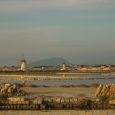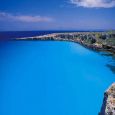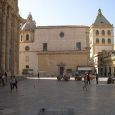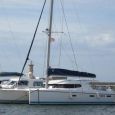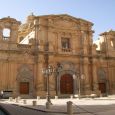Marsala
Advertisement
By Air
The city is served by the Vincenzo Florio Airport in Trapani (located in the territory of Trapani) with daily connections to Turin, Rome, Milan, Pisa, Barcelona, Dusseldorf, Bremen, Dublin, Stockholm and other cities Italian and European, ca 13 km from the city center.
By Ferries
From the port of Marsala is the only scheduled flights, ferries to the islands Egadi easily reached by private boat.
By Train
The railway line that crosses the city from north to south is part of the Palermo-Trapani, Marsala, although not a train station worthy of his greatness.Right next to the station is located an unused area always on the railway line where once was thought to build the Central Station.
By Bus
Marsala is based on bus transport company that serves the whole province and is the terminus of each race from any city in the province of Palermo, then with repeated connections to the capital.It is crossed in a north-south from Highway 115 South West Sicula that connects to the north of Trapani and Marsala on the motorway A29 motorway and south to Mazara del Vallo.The city is also the starting point of Highway 188 West Center Sicula crosses in the sense that the west-east to connect with Salemi.Both sp.21 the Marsala-Fast Scrolling Birgi connect the city to the nearby airport of Trapani.
Baglio Anselmi Archeological Museum
is the most important city of Sicily as it hosts the only example of a Punic ship arrived today.The museum is housed in an old beam site on the outskirts of the city and renovated to house the Marsala Punic ship found in the waters of the city lilibetana in 1971.The most important exhibit of the museum is certainly the Punic ship visited by archaeologists and scholars from around the world, as unique.Other findings contained in the museum are made of ceramics and pottery of Hellenistic and Roman times as well as a series of inscriptions carved on stone slabs.
The Church of the Annunciation
The Church was renewed after 1490.The oldest church became the new sacristy and the houses were converted into chapels.One of them dedicated to St. Onofrio a long-lost marble statue became the burial of Petrulla and his family.As late as 1500 Petrulla raised a chapel for the family in which Griggs was the statue of the Madonna del Popolo designed by Domenico Gagini 1490, now preserved in the cathedral of Marsala.The church was equipped with a front entrance porch, originally covered with wooden floor with three arches and the wider central arch of the other two. Only later on the porch ceiling was raised and replaced by cross vaults when the rebuilding of the convent brought about a redefinition of tables.The portal however is the only one to respond fully to the dictates of the Renaissance, though its edges shaped as thin column still has a lingering type-century, the porch with stone columns calcarenitic has piers at the corners of the same pattern stick-century while it is fully renaissance in the use of the arch. Renaissance is also why the first floor windows overhanging porch and portal access to the convent, dated 1650 similar to those that adorn the entire first floor of the Military District.The Carmelite order discrete economic conditions led to a strong rearrangement of the church in the Baroque period: the system was redesigned into a single nave covered by a dammuso lunette with tall windows on the side arches that identified the chapels.The church was so elevated as evidenced by the gable roof above so inelegant porch and attic above.
The cave of the Sibyl Lilybetana
which connects the grave or what dwells at the Sybil of Cumae and the Sibyl Sicula, just below the church of St. John the Baptist was built in 1555 by the Jesuits on Boeo Cape near the coast.This church however was the first erected on the site but as famous travelers and scholars refer was together with the church of St. Mary of the Cave the ancient abbey of the Basilian Fathers.Over the centuries, the "Cave" became an integral part of worship building sub divo communicating with it. The cave which is -4.80 m is basically formed by a central opening circular shape connected with two rooms, one facing North, the other to the west.The central room, dug in the rock up to a certain height, is covered by a dome low, built of brick, with a skylight connected with the church floor.The center of the room is occupied by a square basin, not very deep, served with water.The northern environment, entirely excavated in the rock, and has a semicircular apse. At floor level a spring that feeds the central basin environment.In front of the cavity is a large stone altar stands a marble image of Saint John the Baptist of the highest importance, dating from the fifteenth century.
Medieval Castle
In the east of the city where the two arms of the Punic ditch meet in an elevated position with respect to the downward slope city with a grand piano in front of free constructions toward the city the medieval castle was built.Founded as a fortified enclosure perhaps only in Norman (but you can not escludeer that in this point there was a Byzantine fortress) was reinforced in the Swabian period as attested by the plant and some pseudo-trapezoidal design elements such as the ribs of a environment of the circular tower typical of Frederick.A letter of 1239 sent to Lodi by Frederick II of Swabia where he asks the executioner Salsum ultra (beyond Salty sel) not to make any restructuring in the castles of Trapani, Marsala, Mazara and Sciacca and to award to citizens fidelibus nostris the maintenance of them to prevent its ruin shows the existence of the Castle at the beginning of the thirteenth century.
Museum of Flemish tapestries
As part of its historical and artistic heritage, including Marsala, a singular gift of one of its most illustrious sons, Monsignor Antonino Lombardo, former bishop of Messina, a valuable set of eight tapestries of the late sixteenth century Flemish, the collection certainly more relevant this cultural art form for the Southern Italy after the famous Battle of Pavia B. Van Orley's Museum of Capodimonte in Naples.It can be seen in a small but impressive building adjacent to the mother church, to which they belong.The "octo Peccia pannorum de race et labora silky wool as stated in the deed of gift of 1589 tell the main events of the conquest of Jerusalem by the Roman Emperor Vespasian and Titus (66-68) according to the text of De Bello Judaica - if not literally - jew writer Josephus, who was also active and influential protagonist of the story of war and peace between the two peoples.The size of sheets range from eight cm And 350x254 cm. 350x500. Essi sono tessuti ad alto liccio (cioè in telaio verticale) con elegante intreccio di lane e sete raffinatamente colorate.
Agricultural Museum Baglio Biesina
Located in the east side of town, on the way Salemi is the Agricultural Museum located inside the Baglio Biesina an old apartment block surrounded by a beautiful typical Sicilian garden full of palm trees. Inside the tools and utensils used by farmers including some dating to the early nineteenth century.
Roman Insula
It is an area outside the original village, occupied by scrub mediterranea.Proprio in this area, the westernmost of the city, are the remains of an old Roman patrician, called "Roman Insula", dating from late Roman Empire was (fourth century BC).Coming to light thanks to a variety effettuatisi excavations from 1939 to today has rich mosaic floors, portraying scenes of conflict between wild animals and mythological figures.There is also a spa setting.There are currently work for the realization of this archaeological park.You can get more information by visiting the voices of Lilybaeum and Mothia.
Theatre Comunale
Gl interventions also allowed to reopen the Royal City Theatre built in the early nineteenth century on the initiative of some noble Marsala.The theater a little jewel with 300 seats in the stalls, boxes and gallery was reopened in 1994 and named after the composer Sollima Heliodorus.
January - May
October - December


